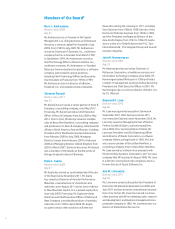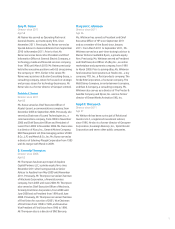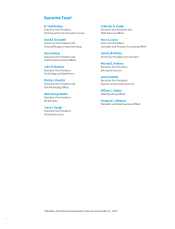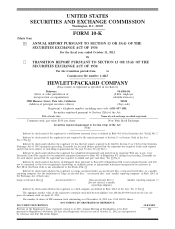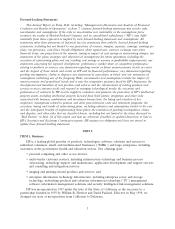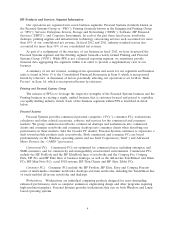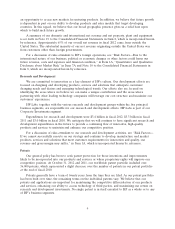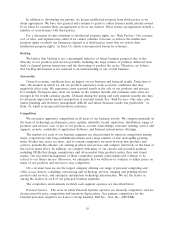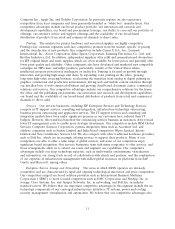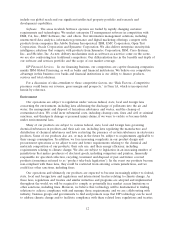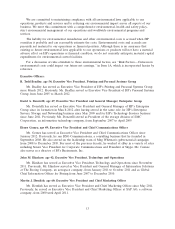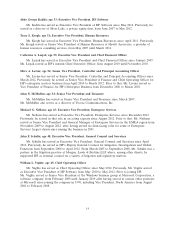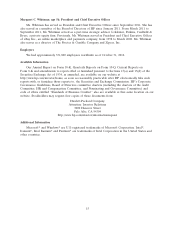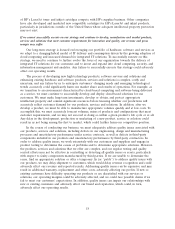HP 2012 Annual Report Download - page 16
Download and view the complete annual report
Please find page 16 of the 2012 HP annual report below. You can navigate through the pages in the report by either clicking on the pages listed below, or by using the keyword search tool below to find specific information within the annual report.strategy, the business segments collaborate to ensure strategic and process alignment where
appropriate.
For large enterprise customers, HP typically assigns an account manager, generally from ESSN or
Services, to manage the customer relationship across HP. The account manager is supported by a team
of specialists with product and services expertise. For other customers and for consumers, PPS manages
direct online sales as well as channel relationships with retailers, while also leading coordination across
the businesses for relationships with commercial resellers targeting SMBs.
Manufacturing and Materials
We utilize a significant number of outsourced manufacturers (‘‘OMs’’) around the world to
manufacture HP-designed products. The use of OMs is intended to generate cost efficiencies and
reduce time to market for HP-designed products. We use multiple OMs to maintain flexibility in our
supply chain and manufacturing processes. In some circumstances, third-party OEMs manufacture
products that we purchase and resell under the HP brand. In addition to our use of OMs, we currently
manufacture a limited number of finished products from components and subassemblies that we
acquire from a wide range of vendors.
We utilize two primary methods of fulfilling demand for products: building products to order and
configuring products to order. We build products to order to maximize manufacturing and logistics
efficiencies by producing high volumes of basic product configurations. Configuring products to order
permits configuration of units to the particular hardware and software customization requirements of
customers. Our inventory management and distribution practices in both building products to order and
configuring products to order seek to minimize inventory holding periods by taking delivery of the
inventory and manufacturing immediately prior to the sale or distribution of products to our customers.
We purchase materials, supplies and product subassemblies from a substantial number of vendors.
For most of our products, we have existing alternate sources of supply, or such sources are readily
available. However, we do rely on sole sources for laser printer engines, LaserJet supplies and parts for
products with short life cycles (although some of these sources have operations in multiple locations in
the event of a disruption). We are dependent upon Intel as a supplier of processors and Microsoft
Corporation (‘‘Microsoft’’) for various software products. However, we believe that disruptions with
these suppliers would result in industry-wide dislocations and therefore would not disproportionately
disadvantage us relative to our competitors. For processors, we also have a relationship with AMD, and
we have continued to see solid acceptance of AMD processors in the market.
Like other participants in the high technology industry, we ordinarily acquire materials and
components through a combination of blanket and scheduled purchase orders to support our
requirements for periods averaging 90 to 120 days. From time to time, we experience significant price
volatility and supply constraints for certain components that are not available from multiple sources.
Frequently, we are able to obtain scarce components for somewhat higher prices on the open market,
which may have an impact on gross margin but does not disrupt production. We also acquire
component inventory in anticipation of supply constraints or enter into longer-term pricing
commitments with vendors to improve the priority, price and availability of supply. See ‘‘Risk Factors—
We depend on third-party suppliers, and our revenue and gross margin could suffer if we fail to
manage suppliers properly,’’ in Item 1A, which is incorporated herein by reference.
International
Our products and services are available worldwide. We believe this geographic diversity allows us
to meet demand on a worldwide basis for both consumer and enterprise customers, draws on business
and technical expertise from a worldwide workforce, provides stability to our operations, allows us to
drive economies of scale, provides revenue streams to offset geographic economic trends and offers us
8


